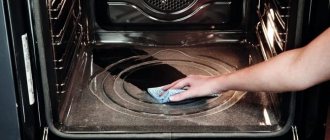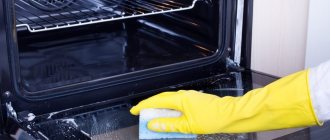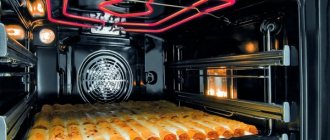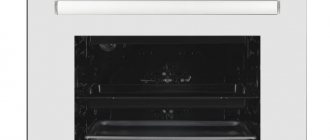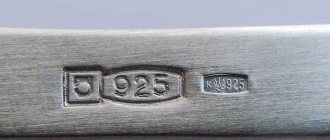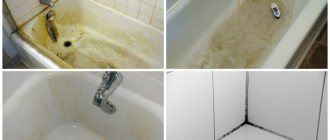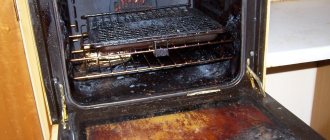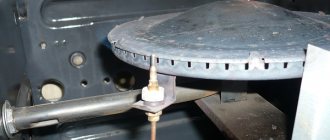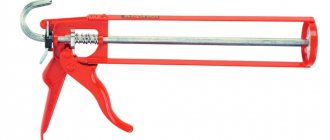Traditional oven cleaning: what is it?
Traditionally, detergent and a sponge are used to clean the oven. The traditional cleaning system is called the usual, “grandmother’s” methods. Sponges, special powders and liquids, as well as folk remedies for removing carbon deposits are used here. The disadvantages of this method are obvious:
- time-consuming and labor-intensive process;
- the need to clean trays and grates separately;
- risk of damage to surfaces.
The only advantages include energy savings and low cost of stoves that are not equipped with a self-cleaning system.
Expenses
The price for this type of equipment is high, and the energy costs are also quite high, but you are completely spared (especially if you have a model with heat-resistant baking trays) from cleaning up greasy deposits. Over many years of using the device, you will save a significant amount on detergents and washcloths. Also, household chemicals will not have a harmful effect on you and your loved ones.
Due to their high quality, these devices rarely break down, and there is no need to buy any parts or change panels as is the case with catalytic plates. Filters are designed to last the entire service life of the equipment; some manufacturers use catalytic self-cleaning filters; in other models, they are removed from time to time and washed by hand.
Cleaning options
Advanced technologies do not stand still, forcing stove developers to find new solutions that make oven care easier. Recently, models have appeared on sale in which the door can be removed. This greatly simplifies regular cleaning of the oven and makes it possible to treat the most difficult to reach places.
Many housewives appreciate the oven, which is equipped with a special trolley that allows you to easily pull out the work surface. If you use this function during frying, you can easily check the readiness of the dish. Cleaning is also simplified: the removed panel is washed separately from the stove.
Some ovens are coated with a special enamel that contains oxidation catalysts, which lead to the breakdown of fats when heated.
The pyrolytic cleaning function is considered the most expensive and high-quality, but it is installed only on electric stoves.
Easy-clean oven enamel: what is it?
The special coating allows you to easily clean the surface of the oven.
Easy-to-clean enamel is a smooth coating on the internal surfaces of an oven that has no pores. Grease and soot can be removed by wiping the walls with a cloth.
This coating saves the housewife from having to spend hours cleaning the oven, but still does not free her from washing surfaces by hand.
Catalytic method
Catalytic oven cleaning is a self-acting reaction that breaks down fat, soot and other substances formed during the cooking process. The process of decomposition of complex compounds into carbon and water is made possible thanks to special plates that cover the inner surface of the oven.
The operating principle of the miracle coating is based on the rules of chemical reactions in a hot environment. It is as follows: during cooking, when the temperature in the oven exceeds 200 degrees, the process of fat breakdown begins. Its course is characterized by the simultaneous removal of decay products, which becomes possible due to the action of nanoparticles.
The reaction proceeds due to the activation of a chemical catalyst, which begins to work automatically as soon as the temperature exceeds the above threshold. It should be noted here that the more the temperature in the oven rises, the more active the splitting process occurs. Its acceleration occurs with the help of copper oxide, cobalt and manganese, which play the role of main catalysts.
Grease-absorbing enamel is applied to all walls of the oven with the exception of the bottom and glass door. This is due to the fact that during the baking process, jam, jam, melted sugar, and milk components often flow down to the bottom of the appliance. By instantly burning on a hot surface, these products can harm the enamel coating, so the bottom of the oven is made of traditional materials.
This built-in self-cleaning function coats the inside of the oven with dark, rough enamel. If you look at it more closely, pores filled with a special chemical composition become noticeable.
When fat gets onto the oven walls during cooking, a reaction occurs under the influence of high temperature, and it quickly breaks down into water droplets and carbon.
Self-cleaning begins to work when the oven is heated above 150 degrees. The optimal temperature for quick cleansing is considered to be 250 degrees. The catalytic method helps keep the oven clean without the slightest effort on the part of the owner. After cooking, she only needs to walk along the inside of the oven with a damp cloth, collecting the ash that has formed as the fat breaks down.
To fully understand what catalytic oven cleaning means, you need to understand that with its help, walls coated with the composition absorb dirt like blotting paper.
Manufacturers producing such stoves do not apply porous enamel to the entire oven. She is situated:
- on the top, back and side walls;
- on the convector blades.
The lower wall is usually not treated with a special compound. This is due to the fact that porous enamel is damaged by sweet syrups and milk drips, which often fall down the oven when baking pies. Therefore, the lower part of the oven will have to be tidied up using cleaning products. This principle also applies to the door - you will also have to clean it yourself.
About the quality of ovens with pyrolytic cleaning
It’s not for nothing that experts jokingly call these appliances the “Mercedes” of ovens. The point is not so much their high cost, but their excellent quality and durability. For the manufacture of the case, high-quality steel is used, which is able to withstand long-term temperature overloads; the internal surfaces are coated with heat-resistant enamel. All materials are made using the most modern technologies, because ordinary materials are simply deformed from such heat.
The very thick glass of the door is made up of 3-4 tempered glasses designed to withstand high temperatures. Despite the fact that such devices have an additional cooling system for the outer surface, the body still heats up to 80-100 °C, so it is recommended not to carry out pyrolysis when There are children and pets in the kitchen.
Products in this series use high-quality thermal insulation. Manufacturers have developed a number of additional measures to make this device safe in everyday life: sensors record the level of temperature and carbon monoxide, the system automatically locks the doors when operating in maximum mode. All automation is designed for long-term operation at high temperatures. Special systems prevent fat from burning in the oven.
Many manufacturers install grease-absorbing filters on the convector grille to protect the fan blades from greasy deposits that prevent rotation.
The design of ovens with pyrolysis corresponds to the price category; they look presentable and expensive. The enamel, unlike the rough coating in catalytic models, looks impeccably smooth. “Pyrolytic” enamel is of very high quality and is designed for many years of service, so if you are forced to save energy, you can wash the oven manually using grease and carbon cleaners.
Features of hydrolysis oven cleaning
As the name suggests, hydrolysis cleaning is the dissolution of contaminants under the influence of water vapor.
As a result, the dirt softens and after the oven has cooled, all that remains is to rinse the surfaces, racks and baking sheets in running water, and, if necessary, clean with a sponge. This method requires much less time and effort than regular cleaning, but the need to use a sponge and fuss with soot can be considered a definite disadvantage.
The catalytic method involves the use of special enamel for coating. This material does not allow fat to “eat” into the surfaces and harden, which makes cleaning the oven compartment easier.
As mentioned above, hydrolysis is a cleaning method using water vapor, and with a catalytic system, surfaces get rid of plaque and carbon deposits due to the characteristics of the panel coating.
Both methods are used not only in electric, but also in gas units, and this is a plus.
We invite you to familiarize yourself with Filtration of vegetable oil on the ABC apparatus
Continuing the comparative analysis, we can say that hydrolysis saves money (there is no need to purchase cleaning agents), and the catalytic method saves physical effort when washing surfaces, since it neutralizes grease. In addition, the catalytic panels will have to be replaced over time.
Which method is better is up to the hostess to decide; in this situation, it all depends on personal preferences.
A distinctive feature of the method of removing food residues using steam is its versatility.
Getting rid of dirt using hot steam is effective only for fresh stains.
Hydrolysis is used in all types of ovens. This method is suitable not only for ovens, but also for microwave ovens.
It should be taken into account that frequent use of hydrolysis causes corrosion of materials. To prevent this situation, you need to opt for models in which the coating is made using high-quality enamel.
Fat accumulations fall into a bowl of hot water. If there is a small amount of dirt on the walls of the device, they can be easily removed. To ensure high-quality cleaning that is safe for the coating, use a soft sponge or cloth.
The essence of the method is that water in a volume of 0.5 liters is poured into a heat-resistant vessel or oven tray. The liquid is heated at a temperature of 90 degrees. Hot steam softens all old dirt.
Be sure to read:
How to light the oven in a gas stove Hephaestus, Greta, Indesit and others
Some models use hydrolysis fluid instead of water. In addition, modern ovens are equipped with an activation function according to a timer, adjustment of cleaning intensity, and process duration.
After steam cleaning is completed, allow the unit to cool. Next, the remaining dirt is removed manually. Allow the oven to dry with the door slightly open for one hour.
The advantages of hydrolysis cleaning include several important factors:
- Low cost and simple process.
- Low level of energy costs.
- Eliminate the possibility of getting burned.
- There is no need to use aggressive, dangerous cleaning agents.
- Cleaning takes 15-30 minutes.
The method also has a number of disadvantages:
- The remaining softened dirt is removed manually.
- The method effectively removes only fresh dirt.
- There is a possibility of damage to the internal coating of the unit.
Some modern models are equipped with additional bells and whistles to improve the hydrolysis cleaning system:
- The “Cleaning” function consists of using special liquids for spraying. To do this, the device is heated to a temperature of 90 degrees. This indicator must be maintained for 15 minutes. After heating, a cleaning spray is applied to the surface. After the cycle is completed, any remaining grease and moisture is removed manually using a cloth.
- The "Aqua clean" function is used at low temperatures. To activate the program you need 0.5 liters of water. The optimal cleaning temperature is 50 degrees. The process takes exactly half an hour. After cleaning is completed, the oven is wiped with a cloth and dried. Place the pan back into the oven. In this case, the door must be open for at least one hour.
How to use
The procedure itself is carried out automatically after manually starting the function.
Before starting this option, you should remove all additional items, namely: baking sheet, grill, guides and pull-out parts that deform when exposed to high temperatures. Some manufacturers produce components from heat-resistant materials, thereby facilitating the use of the cleaning system so that the housewife does not have to spend time removing foreign elements.
Important!
Before using the self-cleaning mode, you should remove all dishes from the oven to cover unforeseen circumstances.
Step-by-step pyrolytic cleaning consists of the following steps:
- Assessment of contamination, selection of the most suitable program and activation of the function;
- When the temperature reaches 300 degrees, the door locks to avoid burns. The control system avoids injuries and ensures complete safety for children and adults;
- Upon completion of the procedure, when the temperature in the oven drops to 200 degrees, the lock will automatically unlock;
- You should open the oven and wait for the device to cool completely;
- Use a soft cloth or brush to remove residues that have turned to ash;
- The device is ready for further use and looks like a new unit;
- You can put back the baking trays, racks and other components.
If cooking in the oven is carried out regularly, this procedure must be applied every week.
Security measures
Compliance with standard rules will help extend the life of kitchen units and ensure safe use for all family members.
When using pyrolysis, you must follow these recommendations:
- The oven is used strictly for its intended purpose - for cooking. Drying mushrooms, herbs and premises is strictly prohibited;
- It is contraindicated to cover the bottom and inner walls of the cabinet with aluminum foil;
- You cannot place baking trays on the bottom; such a moment can lead to damage to the enamel and will interfere with high-quality air circulation;
- Dishes must not be placed on an open door;
- Do not block the ventilation openings.
The health of consumers and the safety of using the unit depend on compliance with this list of rules.
Advantages of the method
Like any other modern technology, catalytic oven cleaning has both strengths and weaknesses. The advantages of the method include a number of important points.
- Full automation of the cleaning process does not require human participation, which greatly simplifies the care of the oven.
- The low temperature threshold for starting the cleansing process, often only 150 degrees, allows you to get rid of fatty contaminants even when using the oven at low temperatures.
- Unlike pyrolytic cleaning, which is carried out after cooking and requires high temperatures and high energy consumption, catalytic cleaning is performed during cooking and does not require additional time and electricity. In addition, this method is much more effective than steam cleaning: it not only breaks down grease and other contaminants, but also removes them from the inner surface of the oven.
- This method is universal; it can be used not only in electric, but also in gas ovens.
- The catalytic cleaning function has virtually no effect on the cost of the oven.
- Pieces of furniture adjacent to the oven do not experience high temperature loads during cleaning, unlike, for example, pyrolysis models, for cleaning which the device heats up to 500 degrees.
The disadvantages of the catalytic procedure include lower purification efficiency compared to pyrolysis. This is due to the fact that only the walls of the appliance are coated, so the grate, metal sheets, grill and door will have to be cleaned manually.
It is also worth noting that special enamel loses its working qualities over time, which is why the plates have to be changed every 5 years. To extend its service life, it is recommended to wipe the enamel only with a soft cloth; the use of rough and rough fabrics is prohibited. However, to be fair, it is worth noting that removable panels of this type often have a double-sided coating. Therefore, if one of the sides loses its working properties, the sheet is safely turned over and used for another 5 years.
Among the disadvantages, there is also incomplete breakdown of fat when the oven is turned on for a short time. However, its final removal necessarily occurs when the device is reused. In this regard, this type of cleaning is more suitable for those who use the oven regularly.
Since catalytic purification is a simple chemical reaction, it does not require complex technologies or expensive components. Therefore, such a system stands out among developments at an affordable price. In addition, it has a number of other advantages:
- significantly saves time spent on stove maintenance;
- the oven does not need to be washed after each cooking;
- cleaning occurs while cooking, so it does not require additionally turning on the oven and wasting electricity or gas;
- The warranty period for the enamel is about 5 years.
We invite you to familiarize yourself with Plastic Cleaner
Over time, the protective coating wears off and must be replaced with a new one. In some models of equipment, the walls are treated with catalytic enamel on both sides. In this case, they need to be turned over to the new side. You can easily carry out the manipulation yourself, as the instructions describe the procedure in detail. But if a person is not able to cope with the work, the service center employees will quickly reinstall the walls.
When using catalytic cleaning, you do not need to select a special place in the kitchen to install the oven. The system works without interruption everywhere and does not heat the stove to such an extent as to damage furniture or other household appliances in the immediate vicinity.
Principle of operation
As noted, during pyrolytic cleaning the oven heats up to a temperature of 500 degrees. In this regard, before starting the procedure, it is recommended to remove all dishes and racks from the device.
Under the influence of this temperature, dirt burns, turning into ash, which must then be removed with a dry or wet cloth. Filter elements are included with ovens equipped with this function. The latter remove unpleasant odors that arise when fat and other contaminants burn. These filters require replacement every 100 hours of pyrolytic cleaning operation.
The principle of pyrolytic purification
Many buyers are interested in what is the difference between pyrolytic and catalytic oven cleaning.
The benefits of purchasing an oven with pyrolysis technology raise some doubts
Pyrolysis is the breakdown of substances due to exposure to high temperatures. Leftover food burns completely, turning into ash and soot.
The benefits of purchasing an oven with pyrolysis technology raise some doubts. Such models have the highest cost compared to other types of food residue removal. On average, the price category is 2 times higher than the cost of other middle-class ovens.
This is due to the quality of the material used to decorate the interior walls. The doors have additional protection against burns.
This type of cleaning is present only in electrical units. Pyrolysis is not economically viable due to the high level of energy consumption. When installing, it is important to consider that the power cable voltage must be 6000 V.
The exception is ovens with “6th sense” technology. Its essence is that the device reacts to the concentration of carbon dioxide, which is released during combustion. When its level begins to decrease, the process stops.
Pyrolysis has its economic advantages. Such ovens serve for a long time without breaking down and do not require frequent replacement of expensive parts. Most of these models are equipped with a self-cleaning function, which significantly reduces the costs required to purchase detergent.
How to use?
How to use an oven with pyrolysis function:
- Remove the kitchen utensils that are in it, take out the baking sheets and racks.
- Select the required mode on the control panel based on the degree of contamination, press the “Start” button. When the temperature rises to 300 degrees, the door will lock to prevent burns. It will be possible to open it again when the cleaning process is completed: the temperature begins to drop and reaches 200 degrees.
- After cooling, remove the resulting ash with a brush, then wipe the surface with a soft cloth.
When using the oven daily, pyrolysis is carried out at least once every 7 days.
Modern models are equipped with additional functions that will help make working with the device easier:
- The presence of a filter that automatically starts the cleaning process after 100 hours of operation.
- Built-in sensor system that tells the housewife that it is time to remove dirt.
- Step-by-step instructions for cleaning the oven, which are displayed on the digital display.
Be sure to read:
How to connect a gas stove with your own hands: step-by-step instructions, installation rules
Ovens with pyrolysis appeared quite recently, but during this time they have evolved.
| Mode | Purpose | Working hours |
| Minimum | Used in cases of light contamination | 2 hours 15 minutes |
| Ordinary | Medium difficulty | 2 hours 40 minutes |
| Maximum | If there is a thick or old layer of fat | 3 hours 15 minutes |
Gradually, almost every manufacturer of household appliances began to produce models based on the needs of customers and use a catalytic filter, which allows them to quickly burn large contaminants and save energy consumption.
Some manufacturers produce ovens in which food is burned in several levels. This allows you to avoid heating the device to maximum temperatures.
Pyrolysis ovens are the highest quality appliances.
This is explained by the fact that high combustion temperatures require appropriate quality material. For the manufacture of such devices, only the highest quality steel is used. The walls and bottom are covered with special enamel that can withstand high temperatures.
The door glass is completely safe. This is achieved thanks to the presence of 3 or 4 tempered glasses. The door locks during operation. The case is equipped with a cooling system, but it is important to consider that the temperature of the device can reach 100 degrees or higher.
There is a safety system inside the unit in case of fire. To do this, sensors are installed that record temperature and carbon monoxide concentrations.
Some brands of ovens have filters that are located on the convector grill. Their task is to protect the fan from contamination.
The oven's durable enamel can be cleaned with regular non-abrasive cleaners. This will help save energy costs.
Among the few disadvantages of this type of cleaning, an unpleasant odor should be noted. This is due to the fact that all residues burn to the ground at a temperature of 500 degrees, and soot is formed.
During cleaning, be sure to turn on the hood and open the kitchen window wide. To solve this issue, you can attach a pipe to the hole in the back wall of the device and lead it into the ventilation system.
If you have a catalytic filter, this problem should not arise. It is designed to operate during the entire service life of the device. Automatic filter cleaning occurs after every 100 hours of operation.
To reduce odor levels, cleaning should be done at least once a week if the unit is used frequently.
Comparison table of oven cleaning types
Each type of cleaning has its own advantages and disadvantages.
We suggest you familiarize yourself with How to remove lipstick from a coat
When making a choice in favor of one technology or another, you should consider:
- how often the device will be used;
- what price segment is acceptable;
- what should be the quality of the materials used;
- Is it important to fully automate the process or is minor manual cleaning allowed?
- what is the power of the electrical wiring;
- Do you have a powerful hood at home?
The pyrolysis model is convenient if it is possible to purchase expensive equipment, a wire with a power of at least 600 W is installed, and the kitchen is equipped with a powerful hood.
Hydrolysis does not require large amounts of electricity, eliminating the possibility of burns. The method is quite simple and cost-effective, but requires additional manual work to remove any remaining burnt fat.
If saving money is a priority, then the best option would be a gas stove with a catalytic type of removal of old contaminants, although this type of equipment is less functional than electric ovens. Catalysis is suitable for frequent use of the stove and will greatly facilitate the process of removing old grease and stains.
No manual oven cleaning
Catalytic cleaning of the oven is carried out in accordance with this principle - the decomposition of fat accumulated during the cooking process into water and soot. Decomposition products are absorbed by a sorbent consisting of nanoparticles. As for the oven coating, it has some features:
- The bottom of the cabinet is not coated with a special agent, so this part is not involved in the sewerage process. This distribution of enamel surfaces is spoiled by sugar and milk. Therefore, the bottom of the cabinet must be cleaned from dirt with a soft sponge and any detergent. This must be done in order to remove any remaining food.
- It is recommended to additionally purchase a grease-absorbing filter. After installing such an element, cleaning improves. The grease-absorbing filter needs to be cleaned periodically - it can even be washed in the dishwasher. First you need to make sure that there are no other dishes or food debris in it, as they can get into the filter cells. Then it will stop working.
- The grease-absorbing coating of ovens wears off over time. After 5 years of use, the side walls will require replacement. In some oven models, the side panels come with double-sided enamel for self-cleaning; after the end of the service life of one side, they only need to be attached with the reverse side. In this case, there is no need to purchase new walls.
Such features of the structure and operation of the components of the device make the oven unique. The remaining features lie in the unique operation of the “smart coating”.
Removing residues after basic cleaning
If you advise choosing this type of camera, then the user can be protected from painful hours of cleaning the device.
When does this impact on pollution occur? Cleaning occurs at the time of cooking as a result of exposure to high temperature to the chemical catalyst. The decomposition of fatty residues begins at a temperature of 140 degrees. The effect reaches maximum effectiveness at a temperature of 200 degrees.
Catalysis occurs during normal operation of the stove - there are no special modes to turn on. The process occurs automatically as a result of chemical reactions.
Note! This processing option is easier compared to the manual type of exposure to pollution. Although the second option (more traditional) should not be completely excluded.
Pyrolytic cleaning
There is also a pyrolytic principle of cleaning the surface of the oven chamber from the inside. Before deciding which option is better, it is worth understanding what pyrolysis is.
Pyrolysis is the process of thermal decomposition of organic and many inorganic compounds. In the chamber, during the pyrolytic cleaning process, fatty and other organic food residues decompose under the influence of very high temperatures.
The operating principle of pyrolytic cleaning of the device’s chamber is precisely the burning of fatty contaminants under the influence of temperatures above 500 degrees. Leftover food turns into soot. Burning residues produces steam with an unpleasant odor. A catalytic filter is used to eliminate unpleasant odors.
The Catholic steam filter does not need to be washed or replaced - it is designed to last the life of the oven and cleans itself automatically. The action occurs approximately once every 100 hours of operation of the oven by calcination.
It turns out that pyrolysis is more effective in comparison with the catalytic purification option. But in any case, additional manual processing is required. At the time of combustion, a disgusting odor may appear, which is not observed with the catalytic type of exposure.
Catalytic self-cleaning
The basis of the operating principle of this technology is the decomposition of fat accumulated after cooking into soot and water, which will then be absorbed by sorbent particles. The bosch oven self-cleansing occurs as soon as you turn on the oven and set the temperature to at least 140 degrees. The technology achieves maximum efficiency at 200 degrees. You don't need to enable, activate or do anything additional. The process is completely automatic.
- Sports diet for burning fat
- The benefits of beets - raw and boiled. Beneficial properties of beets and contraindications, video
- Burning sensation in the chest - causes. What diseases can be a symptom of a burning sensation in the chest area?
Advantages and disadvantages
Despite the positive reviews that the new development is receiving, it has several negative aspects. They must be taken into account when purchasing equipment.
- If, when frying meat, too much fat gets onto the porous enamel, the system does not always completely cope with its breakdown. Therefore, large dirty areas can only be cleaned after repeated use of the oven.
- Some pieces of equipment have to be washed the old fashioned way - by hand. This applies not only to the door and bottom wall, but also to the baking sheets, grill, and grate.
- When the walls of the equipment are not coated on both sides, purchasing new parts can hit the family budget hard. Their average cost depends on the brand of stove and ranges from 2000 to 4000 rubles.
How to choose?
What does catalytic oven cleaning mean? This is a method whose effectiveness increases with regular use of the cabinet. Therefore, it is ideal for those who love to cook and constantly use the oven.
Every modern manufacturer of kitchen appliances has models with a built-in catalytic cleaning function. Its quality does not depend on the cost of the product, since porous enamel is made using the same technology and is purchased by slab manufacturers in finished form for processing the walls of products.
Electric and gas stove models are equipped with catalytic self-cleaning, but when purchasing, you should take into account that gas-powered ovens are less practical.
Types of cleaning
In addition to the usual cleaning of ovens with detergents and a washcloth, there are other techniques that make life much easier. Let's look at the main ones:
- Pyrolysis.
If you use the oven infrequently, then washing it by hand is not a problem, but with regular use it becomes difficult. Thanks to the high temperature, all the rubbish will burn, and you only need to remove the ashes. Of course, this technique has its drawbacks, but the advantages are also obvious - perfect cleaning without much difficulty. It is important that the quality of such equipment is always above average. - Hydrolysis
. This type of oven cleaning is considered second after pyrolysis. In fact, this is an improved method of manual cleaning with detergents. The latter are mixed with water, poured into a container and a special mode is turned on. After turning off the oven, allow it to cool slightly and wipe the surface with a washcloth. The temperature range is from 50 to 100 degrees. Despite the fact that you will have to work with your hands, the steam will soften stubborn grease well, which will make cleaning much easier. - Catalysis
. Catalytic self-cleaning is available in many ovens, which are coated inside with a special compound that is slightly rough to the touch. It consists of cerium oxide, copper and manganese. The porous structure of the surface has tiny catalysts that help break down the fatty components of food residues. The temperature in this mode is low, since oxidation starts in the range of 150-200 degrees.
